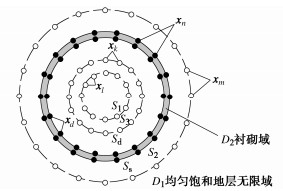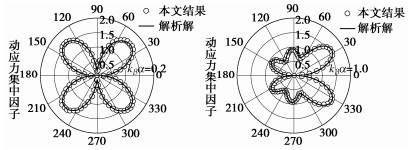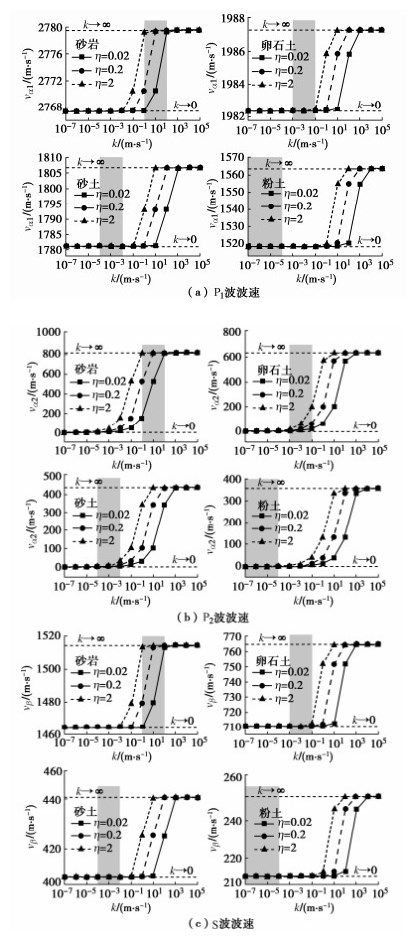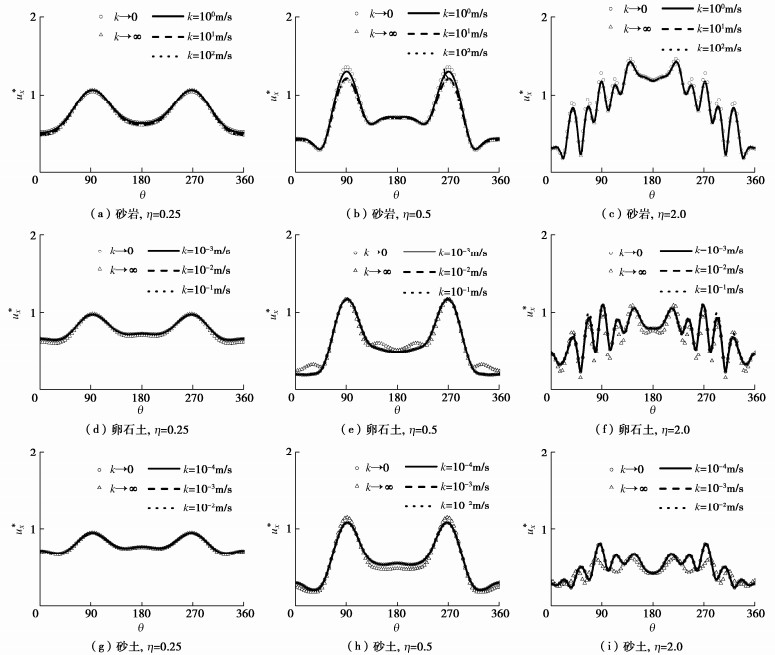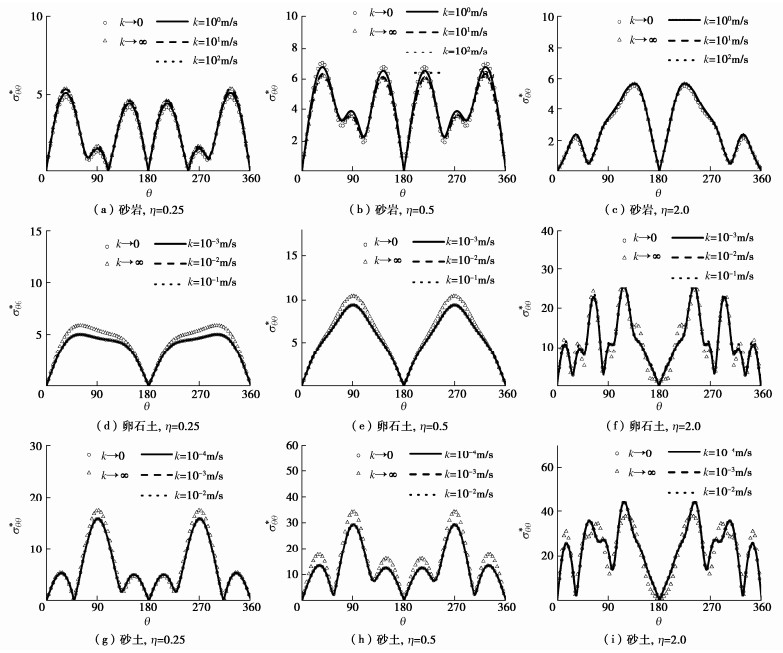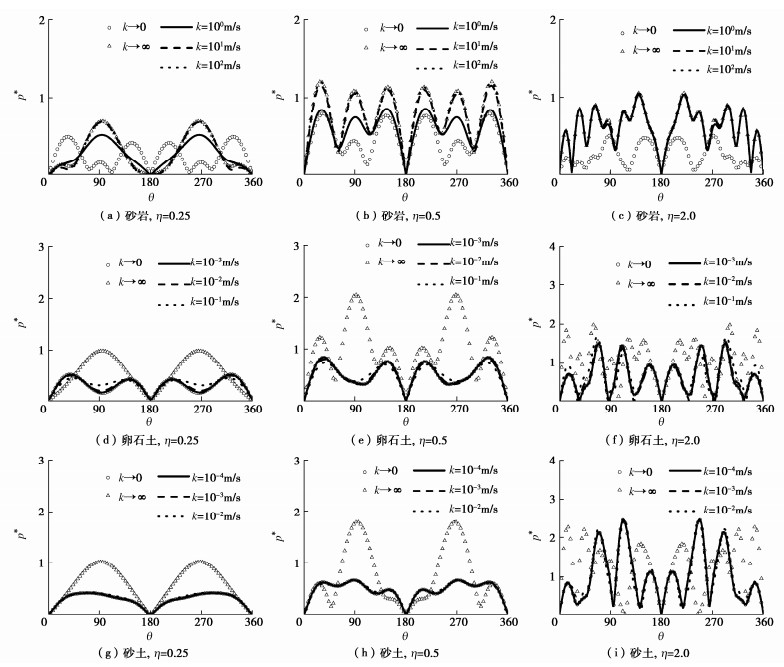Influence mechanism of permeability coefficient in homogeneously saturated strata on responses of deep tunnels under incidence of SV waves
-
摘要: 对于饱和场地中地下结构的抗震分析问题,地层渗透系数决定了孔隙水与土骨架耦合作用的强弱,是研究饱和地层–结构动力相互作用的关键参数之一。然而,目前研究通常基于渗透系数为零或无穷大的假定,忽略了实际地层的渗透特性且对其影响机制尚不清晰。针对不同类型均匀饱和地层对应的渗透系数分布范围,基于Biot两相介质理论,首先建立了饱和地层不同渗透系数情况下的u-w格式模型,推导渗透系数分别为有限值、零和无穷大3种情况下P1,P2,S波的波速解析表达式,分析了地层渗透系数变化对自由场波速的影响规律;进而,建立了不同类型饱和地层与深埋隧道动力作用分析模型,并与典型算例精确解对比验证了本模型的有效性;在此基础上,分别研究了砂岩、卵石土、砂土、粉土4种类型饱和地层渗透系数变化及两种极端值情况下隧道结构及周围地层孔隙水压力的响应机制。结果表明:对于不同类型饱和地层,3种体波在地层中的传播速度均随渗透系数k增加呈上升趋势,当k < 10-4 m/s时,波速为最小值且与k→0极端情况一致,当k > 102 m/s时,波速为最大值且与k→∞极端情况一致;对于饱和砂岩,随着渗透系数增加,隧道及地层孔压响应幅值逐渐增大且趋向于k→∞假设情况,而对于卵石土和砂土,随着渗透系数减小,隧道结构及地层孔压响应幅值逐渐增大且趋向于k→0假设情况。研究还发现,对于渗透系数在10-4~102 m/s范围内的饱和地层,隧道结构与地层响应结果相比渗透系数为两种极端值情况下的结果均相差较大,即此时计算模型不宜采用渗透系数为零或无穷大的假定。因此,实际工程抗震设计应重视饱和地层渗透系数对隧道结构及周围地层的影响。Abstract: For the seismic analysis of underground structures in saturated sites, the coupling effects of pore water and soil skeleton are determined by the permeability coefficient of strata, which is one of the key parameters in the interaction analysis between saturated strata and structures. However, the current researches are usually based on the assumption that the permeability coefficient is zero or infinite, ignoring the permeability of the actual formation, and its influence mechanism is still unclear. Based on the Biot poroelasticity theory, firstly the u-w format model is established for homogeneously saturated strata with different permeability coefficients. According to the distribution ranges of the permeability coefficients corresponding to different types of saturated strata, the analytical expressions for wave velocity of P1, P2 and S waves are derived when the permeability coefficient is finite, zero and infinite respectively, and the influences of variation of the permeability coefficient on the free-field wave velocity is analyzed. In addition, a dynamic analysis model is established for different types of saturated strata and deep tunnels, and the proposed model is verified by providing comparisons with the known solutions of typical examples. Furthermore, the response mechanisms of the tunnel structures and surrounding pore water pressures in four typical saturated strata, including sandstone, pebble soil, sandy soil and silt soil, are investigated under the scenarios of variable permeability coefficients and two extreme values (i.e., zero and infinite). The results show that the propagation velocities of three kinds of waves (P1, P2 and S waves) in different strata all increase with the permeability coefficient k. When k is less than 10-4 m/s, the wave velocity reaches the minimum and is consistent with that of the extreme value k=0. When k is greater than 102 m/s, the wave velocity reaches the maximum and is consistent with that of the extreme value k=∞. More specifically, for the saturated sandstone, the amplitudes of tunnel response and pore water pressure of strata gradually increase with the permeability coefficient and tend to the extreme case with the assumption of k=∞. While for the pebble soil and the sandy soil, the amplitudes of tunnel response and pore water pressure of strata gradually increase with the decrease of the permeability coefficient and tend to the extreme case with the assumption of k=0. What's more, for the saturated strata with permeability coefficient in the range of 10-4 m/s~102 m/s, the dynamic responses of tunnel structures and strata are quite different from those with permeability coefficient of two extreme values, which indicates the assumption that the permeability coefficient is zero or infinite cannot be used in the computational model for this situation. Therefore, the permeability coefficient of saturated strata has a significant influence on the dynamic responses of the tunnel structures and surrounding strata, and should be considered in the seismic design of practical projects.
-
0. 引言
水下抛填散粒料常被用来填筑围堰基础,例如白鹤滩工程围堰、大藤峡二期深水围堰、碾盘山围堰等。水下抛填散粒料的相对密度是围堰和大坝工程设计中最基本的物理参数之一,直接决定了抛填料的强度参数和变形模量,是进行工程变形和稳定分析的关键参数[1],但是如何准确、合理地确定抛填相对密度仍存在困难[2]。
目前,国内外许多学者研究了典型散粒料的抛填密度问题。程永辉等[3]采用静态抛填离心试验方法研究了风化砂、石渣料和砂砾石的水下抛填密度,指出进占式水下抛填深度越大,由于抛填料运动至深部动能也较大,且受后期抛填料的压实作用也越大,因此形成的密度较大。李青云等[4]通过对三峡工程二期深水高土石围堰运行后的实测分析,一般位置的水下部分(66 m高程以下)堰体密度实测值在1.83~1.98 t/m3之间,与用离心模型试验确定的水下抛填风化砂密度(1.75~1.85 t/m3)相比,略有增长,考虑的围堰4 a运行中的固结效应,二者基本一致,有力证明了采用离心模型试验方法确定的风化砂水下抛填密度的科学性和可行性。Mahmoudi等[5]通过开展一系列重塑饱和砂土试样的不同超固结比不排水三轴试验,结果表明初始相对密度以显著的方式控制不排水抗剪强度,初始相对密度的增加导致膨胀性的放大,从而导致不排水抗剪强度的增加[6]。Wei等[7]采用砂子和两种不同粒径的砂砾石混合,砂砾石的粒径分别为5~10,10~20 mm,两种混合料的最大密度和最小密度随着砂砾石含量的增大均逐渐增大,当砂砾石的含量为75%时达到最大值,砂砾石含量相同时粒径较大的砂砾石得到的密度较大。Chang等[8]对松散状态的宽颗粒级配土,通过不同含砾量的间隙级配砂和级配砂的人工配制试样开展系列排水单剪试验,表明砾石土抗剪强度取决于优势颗粒的充填条件,其中颗粒间孔隙比比整体孔隙比更能代表土体的充填条件。Kalman[9]对比分析不同细颗粒掺入粗颗粒时密度变化,混合料的最大密度和最小密度与细颗粒的粒径以及掺入量密切相关,密度基本随着细颗粒掺入量的增加先增大后减小。Chen等[10]指出颗粒材料的岩土力学性能严格依赖于其初始堆积密度、应力水平和粒度分布,二元颗粒土的性能还受其细小颗粒的质量和数量的影响,峰值抗剪强度随细小颗粒含量的变化呈钟形,与初始填充密度和应力水平无关,与粒径比值有关。因此,颗粒材料的抛填密度决定了其物理力学特性,直接影响了围堰构筑物的变形和稳定,但现有研究无法得到统一的研究结论或计算方法,不同区域的抛填料密度跟颗粒大小和级配直接相关。
以汉江某水电站大坝水下抛填工程为原型条件,开展砂砾石和沙子混合料的进占式水下抛填密度离心试验,将相对密度Dr作为衡量标准,主要研究散粒料颗粒级配等因素对水下抛填密度的影响规律。
1. 单戗立堵水下抛填离心试验设计
1.1 原型条件和概化
汉江某水电站项目为Ⅱ等大(2)型工程,二期主河床土石坝最大坝高为22.58 m,且坝基需要在水下进行抛投填筑,最大水深为12 m。水下抛填料主要采用汉江河床内的散粒料,为砂砾石和砂子混合料。通过现场筛分得到典型的颗粒级配曲线如图 1所示。
现场筛分试验结果表明填料的最大粒径小于100 mm,0.5 mm以下的含量分别为24.6%,32.1%,49.1%,而0.5~2 mm之间的含量分别为1.9%,1.8%,2.1%,计算得到三种抛填料的不均匀系数Cu分别为153,169,53,曲率系数Cc分别为4.49、1.14和0.11。其中,不均匀系数Cu是限制粒径与有效粒径的比值,是反映组成土的颗粒均匀程度的一个指标。曲率系数Cc是反映土的粒径级配累计曲线的斜率是否连续的指标系数。当Cu≥5且Cc=1~3的土为级配良好,现场筛分得到的3种砂砾石抛填料颗粒级配曲线。表明XJ2下游围堰为级配良好,而XJ1上游围堰和XJ3下游围堰料场均为级配不良。
1.2 试验方案
共开展3种抛填料的水下抛填试验,抛填料主包括:XJ-1、XJ-2和XJ-3分别为上游围堰、下游围堰及下游围堰附近的砂砾石。研究内容主要为现场实际12 m水深条件以及12 m水深+14.3 m上覆堆载的水下抛填密度;对比分析不同水深(5~20 m)的水下抛填密度规律。单戗立堵水下抛填离心试验方案如表 1所示。
表 1 单戗立堵水下抛填离心试验方案Table 1. Centrifugal test plans for single embankment vertical blocking underwater dumping and filling编号 抛填料 试验内容 XJ-1 砂砾石,上游围堰级配 设定最大离心加速度40g,模拟原型进占式抛填方式
试验工况:12 m水深条件下水下抛填密度;12 m水深+14.3 m上覆堆载下的水下抛填体密度;不同水深(5~20 m)的水下抛填密度变化规律XJ-2 砂砾石,下游围堰级配 XJ-3 砂砾石,下游围堰堤头附近级配 1.3 模型抛填料
由于原型填料的粒径尺寸较大,在离心模型试验中不能按原型进行试验,需进行缩尺模拟。综合考虑模型箱和模型断面尺寸,以模型箱最小尺寸的1/20即2 cm作为离心模型试验中砂砾石料的最大限制粒径。本次试验采用等量代替法模拟原型抛填料,即用2~20 mm的各级土料等量代替原型料中20 mm以上的填料,2 mm以下用原型料,模型抛填料级配曲线如图 2所示。
对于粗粒土的相对密度试验,最大密度试验采用振动台法,最小密度试验采用固定体积法,试验结果如表 2所示。3种模型抛填料的最大密度和最小密度分别为2.12,1.88 g/cm3;2.10,1.85 g/cm3;1.99,1.73 g/cm3。
表 2 模型抛填料的最大密度和最小密度Table 2. Maximum and minimum densities of model filling materials编号 抛填料 最大密度/(g·cm-3) 最小密度/(g·cm-3) XJ-1 砂砾石,上游围堰级配 2.12 1.88 XJ-2 砂砾石,下游围堰级配 2.10 1.85 XJ-3 砂砾石,下游围堰堤头附近级配 1.99 1.73 1.4 离心场中水下抛填装置
试验在长江科学院CKY-200型现代化多功能土工离心机上完成。离心机的主要性能参数:有效容量为200g·t;最大加速度200g,无级调速,调速精度0.1g;有效半径3.7 m;吊蓝净空尺寸1.2 m×1.0 m×1.5 m;模型箱尺寸(长×宽×高)为100 cm×40 cm×80 cm。
试验研制了单戗立堵水下抛填离心试验装置,能够实现离心机运行(离心加速度不大于100g)过程中模拟水下抛填的单戗立堵进占方式,断面设计图如图 3(a)所示,模型图如图 3(b)所示。当离心加速度逐级增大至设计加速度时,启动电动提升装置,通过钢丝绳和滑轮连接,将模型箱中部隔板缓慢拉出,隔板上部填料随着开口增大依次落入模型箱下部的水中。该装置主要特点是通过隔板与滑槽之间采用滑轮接触,尽可能减少摩阻力;设置溢流孔和集水箱,保证抛填模拟过程中水位保持不变。
2. 水下抛填离心试验结果及分析
通过离心试验得到的三种抛填料水下抛填密度结果如表 3和图 4所示。表 3为单戗立堵水下抛填后得到平均相对密度,图 4为12 m水深以及12 m水深+14.3m厚上覆堆载条件相对密度-深度的关系。本次试验抛填密度采用灌水法测得,首先通过预留排水管将模型中的水排出,依次将5,12,15,20 m四个深度处一定厚度的抛填料取出,采用灌水法测量取出抛填料的体积,计算得到不同深度处平均干密度,进而计算相对密度Dr。相对密度Dr是指无黏性土处于最松状态的孔隙比与天然状态或给定孔隙比之差和最松状态孔隙比与最紧孔隙比之差的比值。
表 3 单戗立堵水下抛填离心试验结果Table 3. Centrifugal test results for single embankment vertical blocking underwater dumping and filling编号 抛填料 水下抛填密度 12 m水深条件 12 m水深+14.3 m上覆堆载 干密度/ (g·cm-3) 相对密度 干密度/(g·cm-3) 相对密度 XJ-1 砂砾石,上游围堰级配 1.951 0.33 2.012 0.58 XJ-2 砂砾石,下游围堰级配 1.936 0.36 2.016 0.68 XJ-3 砂砾石,下游围堰堤头附近级配 1.788 0.27 1.852 0.52 表 3分析表明,水下抛填密度与颗粒级配是否良好密切相关,12 m水深条件下XJ1~XJ3水下抛填相对密度分别为0.33,0.36,0.27,基本都处于松散~中密的过渡阶段。其中,XJ2的水下抛填密度相对大一些,主要原因是XJ1和XJ3的曲率系数Cc分别为4.49和0.11,为级配不良,而XJ2级配良好。当增加14.3 m厚上覆荷载后,XJ1~XJ3水下抛填相对密度均增大,分别为0.58,0.68和0.52,XJ2达到密实状态,上覆荷载作用能够有效增大抛填区域尤其是浅部抛填料的相对密度。
图 4表明一定水深条件下抛填料的相对密度随着深度而逐渐增大,与包承纲[1]、程永辉等[3]得到的规律一致。XJ2相对密度显著均大于XJ1和XJ3,主要是因为XJ2级配良好,粒径尺寸逐级减小,较小粒径能够尽可能填补上一级粒径的孔隙。当抛填料上部增加14.3 m上覆堆载时,水下抛填体的相对密度均增大,上部增幅较大,可达0.4以上,随深度增幅逐渐减小,深度20 m时增幅仅为0.03左右。结果表明上覆荷载作用可有效增大相对密度,尤其对于水下抛填形成相对密度较小的浅部抛填料增幅最为显著。当抛填料的级配良好时,水下抛填联合上部堆载作用可使得抛填体达到密实状态(Dr>0.67)。
3. 散粒料抛填相对密度简化分析
基于二元颗粒“填隙”理论[11],建立了散粒料抛填相对密度简化计算方法,主要考虑抛填料级配、抛填深度、上覆堆载等影响因素。两粒径理想颗粒的孔隙比被定义为
e=e0+Δeh+Δep−kfill。 (1) 则相对密度Dr:
Dr=emax−eemax−emin。 (2) 式中,e0为初始孔隙比,为最大粒径组的初始孔隙比;Δeh和Δep分别为抛填料深度和上覆荷载作用引起的孔隙比变化,可根据固结试验e-p曲线得到;kfill为颗粒级配(不均匀系数Cu和曲率系数Cc)引起的孔隙比变化。
本次离心模型试验填料为砂砾石,测试得到颗粒相对质量密度Gs为2.65;最大粒径组为10~20 mm,相对密度约为0.38;级配填料的最大孔隙比emax和最小孔隙比emin如表 4所示。
表 4 模型抛填料的最大和最小孔隙比Table 4. Maximum and minimum void ratios of model filling materials编号 抛填料 emax emin XJ-1 砂砾石,上游围堰级配 0.41 0.25 XJ-2 砂砾石,下游围堰级配 0.43 0.26 XJ-3 砂砾石,下游围堰堤头附近级配 0.53 0.33 根据填料初始为最松散状态的固结试验e-p曲线绘制孔隙比随压力的关系曲线,得到相对密度-竖向压力的关系,如图 5所示。
参照Rosin-Rammler采用指数函数表示粒度分布的关系式,粒度分布宽度w为
w=lg(DmaxDmin)=lgDen√ln100R(Dmax)Den√ln100R(Dmin)。 (3) 式中:De为特征粒径;R为筛余量;Dmax和Dmin分别为最大和最小粒度。XJ2级配良好,颗粒级配引起的孔隙比变化为0.05;XJ1和XJ3级配不良,其值分别为0.14和0.12。
采用本文提出的散粒料抛填相对密度简化分析方法得到的相对密度与离心试验结果对比如图 6所示。结果表明,计算值与离心试验结果基本一致,最大相对误差小于5%。
4. 结论
(1)通过单戗立堵水下抛填砂砾石离心模型试验,研究了汉江某水电站典型级配条件水下抛填密度分布规律和主要影响因素,得到抛填密度随深度的分布规律,分析了颗粒级配特征(不均匀系数Cu和曲率系数Cc)对密度的影响。
(2)研制了离心场中单戗立堵水下抛填试验装置,该装置使用最大加速度为100g,能够模拟最大抛填水深为30 m,水平抛填范围40 m,实现了抛填过程中水深条件保持不变。
(3)对于汉江典型砂砾石抛填料,颗粒级配条件对抛填相对密度起着控制作用。当抛填料级配良好时,相对密度较大,当抛填料上部施加一定的堆载后,相对密度会得到进一步提高,平均值可达到相对密实状态。研究成果为围堰和土石坝中水下抛填散粒料的设计和施工提供试验依据。
-
表 1 不同类型饱和土渗透系数分布范围
Table 1 Permeability coefficients of saturated soils
饱和地层类型 静力作用下渗透系数范围k/(m·s-1) 地震作用下渗透系数范围k/(m·s-1) 岩石、堆石料等 101~10-1 1.9×102~1.9×100 级配好卵石土、砾石等 10-2~10-4 1.9×10-1~1.9×10-3 级配较好砂土等 10-3~10-5 1.9×10-2~1.9×10-4 粉土、黏质、砂细砂等 10-5~10-8 1.9×10-4~1.9×10-7 淤泥质黏土等 10-8~10-11 1.9×10-7~1.9×10-10 表 2 4类饱和地层参数及渗透系数范围
Table 2 Four types of parameters of saturated soils and range of permeability coefficient
饱和地层 剪切模量/MPa 泊松比 土颗粒体积模量/MPa 液体体积模量/MPa 土骨架平均体积模量/MPa 固体密度/(kg·m-3) 液体密度/(kg·m-3) 孔隙率 渗透系数[11] /(m·s-1) 砂岩[13] 3700 0.20 36000 2000 6166.7 2650 1000 0.300 1~102 卵石土[14] 854.7 0.17 45000 2000 1010.1 2150 1000 0.400 10-2~1 砂土[14] 277.8 0.26 30000 2000 486.1 2100 1000 0.400 10-4~10-2 粉土[14] 64.15 0.30 20000 2000 139.0 1970 1000 0.594 10-7~10-4 表 3 衬砌材料参数
Table 3 Lining material parameters
弹性模量/GPa 泊松比 密度/(kg·m-3) 32.5 0.2 2500 -
[1] 黄雨, 叶为民, 唐益群, 等. 上海深厚饱和覆盖土层的动力耦合地震反应分析[J]. 岩土力学, 2002, 23(4): 411–416. doi: 10.3969/j.issn.1000-7598.2002.04.004 HUANG Yu, YE Wei-min, TANG Yi-qun, et al. Coupled seismic response analysis of deep saturated soil covering layers in Shanghai[J]. Rock and Soil Mechanics, 2002, 23(4): 411–416. (in Chinese) doi: 10.3969/j.issn.1000-7598.2002.04.004
[2] WANG Z H, ZHAO C G, DONG L. An approximate spring-dashpot artificial boundary for transient wave analysis of fluid-saturated porous media[J]. Computers and Geotechnics, 2009, 36(1/2): 199–210.
[3] 谷音, 庄舒曼, 卓卫东, 等. 考虑饱和土的地铁车站结构非线性地震反应研究[J]. 岩土力学, 2015, 36(11): 3243–3251. https://www.cnki.com.cn/Article/CJFDTOTAL-YTLX201511028.htm GU Yin, ZHUANG Shu-man, ZHUO Wei-dong, et al. Analysis of nonlinear seismic response of subway station considering saturated soil[J]. Rock and Soil Mechanics, 2015, 36(11): 3243–3251. (in Chinese) https://www.cnki.com.cn/Article/CJFDTOTAL-YTLX201511028.htm
[4] 李亮, 吴利华, 王相宝, 等. 基于流固耦合动力模型的饱和土体-隧道体系地震反应研究[J]. 地震工程学报, 2016, 38(6): 862–868. https://www.cnki.com.cn/Article/CJFDTOTAL-ZBDZ201606003.htm LI Liang, WU Li-hua, WANG Xiang-bao, et al. Seismic response of saturated soil-tunnel system based on fluid-solid coupling dynamic model[J]. China Earthquake Engineering Journal, 2016, 38(6): 862–868. (in Chinese) https://www.cnki.com.cn/Article/CJFDTOTAL-ZBDZ201606003.htm
[5] LI P, SONG E X. A viscous-spring transmitting boundary for cylindrical wave propagation in saturated poroelastic media[J]. Soil Dynamics and Earthquake Engineering, 2014, 65: 269–283. doi: 10.1016/j.soildyn.2014.06.022
[6] LIU Z X, JU X, WU C Q, et al. Scattering of plane P1 waves and dynamic stress concentration by a lined tunnel in a fluid-saturated poroelastic half-space[J]. Tunnelling and Underground Space Technology, 2017, 67: 71–84. doi: 10.1016/j.tust.2017.04.017
[7] FETTER C W. Applied Hydrogeology[M]. Long Grove: Waveland Press, 1994.
[8] 刘中宪, 琚鑫, 梁建文. 饱和半空间中隧道衬砌对平面SV波的散射IBIEM求解[J]. 岩土工程学报, 2015, 37(9): 1599–1612. https://www.cnki.com.cn/Article/CJFDTOTAL-YTGC201509008.htm LIU Zhong-xian, JU Xin, LIANG Jian-wen. IBIEM solution to scattering of plane SV waves by tunnel lining in saturated poroelastic half-space[J]. Chinese Journal of Geotechnical Engineering, 2015, 37(9): 1599–1612. (in Chinese) https://www.cnki.com.cn/Article/CJFDTOTAL-YTGC201509008.htm
[9] HAN B, ZDRAVKOVIC L, KONTOE S. Numerical and analytical investigation of compressional wave propagation in saturated soils[J]. Computers and Geotechnics, 2016, 75: 93–102. doi: 10.1016/j.compgeo.2016.01.019
[10] BIOT M A. Mechanics of deformation and acoustic propagation in porous media[J]. Journal of Applied Physics, 1962, 33(4): 1482–1498. doi: 10.1063/1.1728759
[11] WONG H L. Diffraction of P, SV, and Rayleigh waves by surface topography[M]. California: University of California, 1979.
[12] 钟启凯. 地下圆形组合衬砌洞室在地震波下的动力反应分析[D]. 长沙: 湖南大学, 2009. ZHONG Qi-kai. Dynamic Response Aanalysis of Underground Cylindrical Composite- Lining Cavern Subjected to Seismic Waves[D]. Changsha: Hunan University, 2009. (in Chinese)
[13] LIN C H, LEE V W, TRIFUNAC M D. The reflection of plane waves in a poroelastic half-space saturated with inviscid fluid[J]. Soil Dynamics and Earthquake Engineering, 2005, 25(3): 205–223. doi: 10.1016/j.soildyn.2004.10.009
[14] 宋佳. 饱和土场地波动数值模拟方法及其工程应用[D]. 北京: 北京工业大学, 2017. SONG Jia. Wave Numerical Method of Saturated Site Soil and its Engineering Application[D]. Beijing: Beijing University of Technology, 2017. (in Chinese)
[15] HASHASH Y M A, HOOK J J, SCHMIDT B, et al. Seismic design and analysis of underground structures[J]. Tunnelling and Underground Space Technology, 2001, 16(4): 247–293. doi: 10.1016/S0886-7798(01)00051-7
[16] 李瑞山, 袁晓铭, 吴晓阳. 抗震规范等效剪切波速简化算法适用性研究[J]. 地震工程与工程振动, 2018, 38(3): 30–36. https://www.cnki.com.cn/Article/CJFDTOTAL-DGGC201803004.htm LI Rui-shan, YUAN Xiao-ming, WU Xiao-yang. Study on the applicability of simplified equivalent shear wave velocity calculation method in seismic design code[J]. Earthquake Engineering and Engineering Dynamics, 2018, 38(3): 30–36. (in Chinese) https://www.cnki.com.cn/Article/CJFDTOTAL-DGGC201803004.htm




 下载:
下载:






